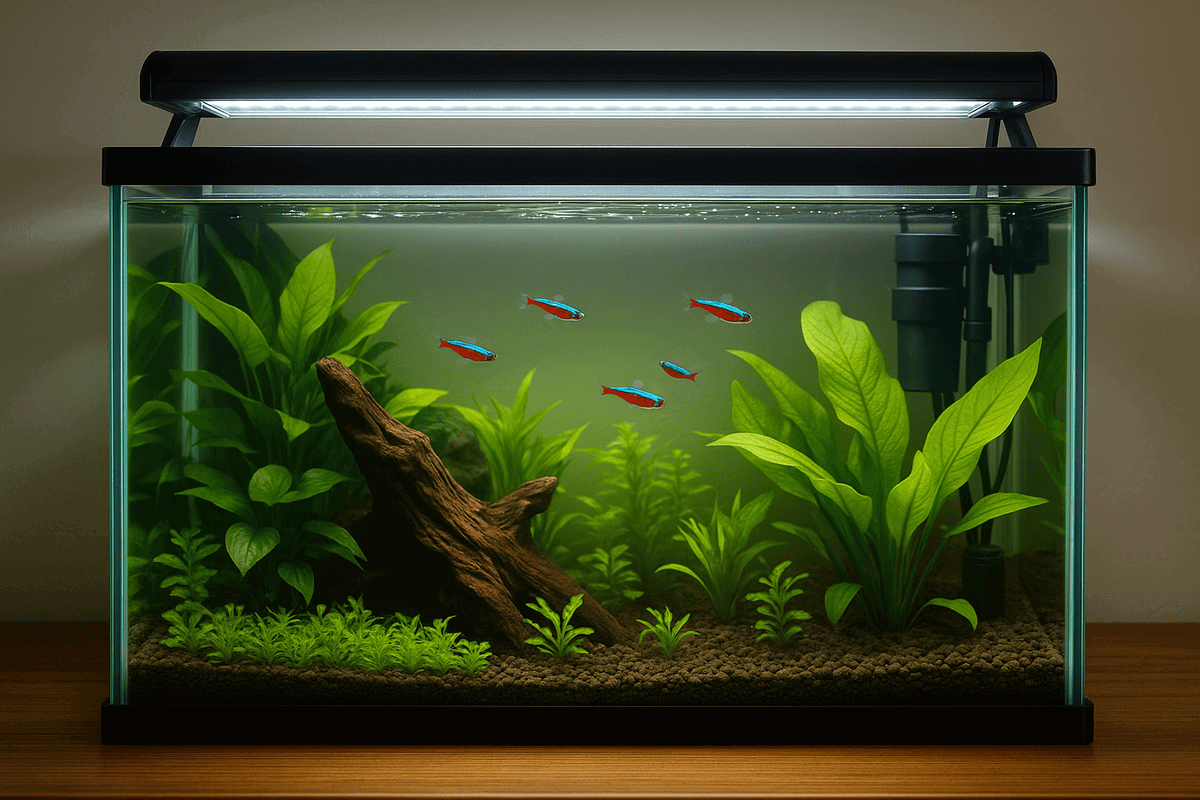9 Eco-Friendly Tips for a Green Freshwater Aquarium
Creating a beautiful freshwater aquarium doesn’t have to come at the expense of the environment. In fact, many aquarists are now embracing eco-conscious habits to reduce their ecological footprint while maintaining healthy, vibrant tanks. Whether you're a beginner or a seasoned hobbyist, adopting greener practices in your aquarium setup and care can lead to more sustainable fishkeeping—and a healthier home for your aquatic pets.
Ready to make your aquarium more planet-friendly? Here are 9 eco-friendly tips that will help you maintain a green freshwater aquarium, both in terms of color and environmental impact.

Why Go Green with Your Aquarium?
Aquariums offer a peaceful escape and a connection to nature, but they also require energy, water, and manufactured products—resources that, if not managed carefully, can contribute to environmental issues like excessive energy use and plastic waste. The fishkeeping industry is evolving to recognize the importance of sustainability, and more eco-friendly options are becoming available every year.
Going green with your aquarium isn’t just good for the planet—it can also lead to:
- Lower electricity and water bills
- Healthier fish and plants
- Longer-lasting equipment
- A more natural and balanced tank environment
So, whether you're starting from scratch or already have an established tank, it's never too late to make sustainable choices.
1. Choose Energy-Efficient Equipment
What to do: Opt for LED lighting, low-wattage heaters, and energy-efficient filters.
Aquariums can be surprisingly power-hungry, especially larger setups. Traditional fluorescent lights and high-wattage heaters can use a lot of electricity over time. LED lights, on the other hand, use up to 80% less energy and last significantly longer. They also produce less heat, which means your heater doesn’t have to work as hard.
Eco tip: Look for products with Energy Star ratings or those designed specifically for low energy use. Brands like Fluval, NICREW, and Aqueon offer efficient lighting and filtration systems.
2. Use a Timer for Lights and Equipment
What to do: Set up timers to control lighting and filtration schedules.
Running your lights 24/7 isn’t just unnecessary—it can lead to algae blooms and spike your electricity bill. Most freshwater fish and plants thrive on a regular day-night cycle of 8–10 hours of light. Using timers ensures consistency while saving energy and reducing light pollution in your home.
Eco tip: Smart plugs with scheduling features can automate your setup and even be controlled from your phone. These are great for vacation periods too!
3. Go for Live Plants Instead of Plastic
What to do: Decorate with live aquatic plants rather than plastic décor.
Live plants don’t just look more natural—they also help purify the water by absorbing nitrates and CO2, producing oxygen, and providing hiding spots for fish. Unlike plastic plants, which are manufactured using petroleum-based materials and may eventually end up in landfills, live plants are completely biodegradable and beneficial to your tank’s ecosystem.
Eco tip: Choose hardy, low-maintenance species like Anubias, Java fern, Amazon sword, Hornwort, and Duckweed. These plants are ideal for beginners and thrive in a range of water conditions.
4. Recycle and Reuse Aquarium Supplies
What to do: Repurpose old tank items instead of discarding them.
Before tossing old tanks, decorations, or equipment, consider how they might be reused. An old aquarium can be turned into a terrarium, quarantine tank, or even a container garden. Broken equipment may have usable parts, and certain substrates can be rinsed and reused.
Eco tip: Connect with local aquarium hobbyist groups on Facebook Marketplace or Reddit—many people are happy to trade or give away supplies they no longer need.
5. Buy Fish and Plants Responsibly
What to do: Support ethical breeders and avoid wild-caught species.
Wild-caught fish, especially from sensitive ecosystems, can contribute to the depletion of natural populations and damage fragile habitats. Whenever possible, choose captive-bred fish and locally grown plants from reputable sources. These tend to be hardier and better adapted to life in a tank.
Eco tip: Be cautious with species that are invasive in your region. Never release aquarium plants or fish into the wild—it can have devastating ecological effects.
6. Use Eco-Friendly Water Treatments
What to do: Choose aquarium treatments with minimal environmental impact.
Many traditional water conditioners and medications contain chemicals that can be harmful if disposed of improperly. Seek out natural or organic water conditioners, which use plant extracts or vitamins instead of harsh chemicals.
Eco tip: Always follow dosing instructions precisely, and never pour leftover treatments down the drain. If you're unsure, check your local hazardous waste guidelines for proper disposal.
7. Practice Efficient Water Changes
What to do: Use a gravel vacuum to clean your tank while conserving water.
While regular water changes are essential for maintaining a healthy aquarium, they can also waste a lot of water if not done thoughtfully. You can reduce waste by using a gravel vacuum to clean and remove water at the same time. Collect this water in a bucket and reuse it to water your houseplants or garden—it's rich in nutrients!
Eco tip: Consider installing a water flow restrictor or using a siphon that connects directly to a garden or outdoor area.
8. Feed Your Fish Sustainably
What to do: Choose fish food from eco-conscious brands and avoid overfeeding.
Some fish foods are made with ingredients that contribute to overfishing or habitat destruction, such as unsustainably harvested krill or anchovies. Look for brands that use responsibly sourced ingredients, such as Bug Bites by Fluval, which uses black soldier fly larvae, or New Life Spectrum with sustainably sourced ingredients.
Eco tip: Store dry foods in airtight containers to reduce waste and avoid spoilage.
9. Reduce Plastic Waste in Packaging
What to do: Buy in bulk and avoid individually wrapped products.
From filter cartridges to water conditioners, aquarium supplies often come in plastic-heavy packaging. Buying in bulk not only reduces the cost per unit, but also minimizes packaging waste. Some companies also offer refill stations or containers made from recycled materials.
Eco tip: Consider brands with compostable packaging or reusable containers. You can also find filter media in bulk, allowing you to fill reusable media bags instead of buying disposable inserts.
Common Mistakes That Aren’t Eco-Friendly
Even well-meaning fishkeepers can fall into some not-so-green habits. Here are a few to watch out for:
- Overstocking the tank – leads to more waste, higher energy use, and frequent water changes
- Using single-use filter cartridges – often tossed monthly, adding to plastic waste
- Ignoring maintenance – results in system inefficiencies and higher energy costs
- Leaving lights on too long – not only wastes energy but encourages algae overgrowth
- Flushing medications or chemicals – harmful to local waterways
Avoiding these pitfalls is an easy way to improve both tank health and environmental impact.
FAQ: Green Aquarium Practices
Can I use solar power for my aquarium?
Yes, it’s possible—especially for small tanks. Portable solar panels can power LED lights, air pumps, or heaters with battery backup. Full solar systems for large tanks are available, but more expensive upfront.
Are live plants hard to care for?
Not at all! Many beginner-friendly plants like Java moss, Hornwort, and Anubias thrive with minimal light and attention.
Is DIY better for the environment?
Often, yes! Making your own filter media bags, food, or decorations using recycled materials reduces manufacturing impact and packaging waste.
What about saltwater tanks—can they be eco-friendly too?
They can, but they require extra care. Reef-safe products and captive-bred marine species are a must. This article focuses on freshwater aquariums, but the principles are similar.
Final Thoughts
Running a freshwater aquarium doesn't have to come at the planet’s expense. With just a few mindful adjustments, you can lower your environmental impact, save money, and create a thriving ecosystem for your aquatic pets.
Eco-friendly fishkeeping isn’t just a trend—it’s part of a growing awareness that every choice we make matters. Whether it’s switching to LED lights, adding live plants, or reducing single-use plastics, your small steps can make a big difference.
And the best part? A green aquarium is often more natural, more balanced, and more beautiful—a win-win for you, your fish, and the Earth.
Peter Lane
Here to share the lessons I've learned, the money and time-saving tips, and the little tricks that have made a big difference in fostering a thriving aquatic environment.

